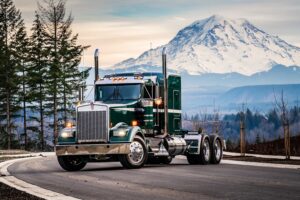COLUMBUS, Ind. — One of the forums during ACT Research’s Market Vitals conference last month featured some familiar names. The one-hour discussion, hosted by industry analyst and forecaster ACT Research, featured Dana, Bendix and Eaton. For many years, commercial vehicles have been put together using products manufactured by one or more of these companies.
Changes in technology have led to a few changes in focus at each of these firms, which also serve the automotive and off-road vehicle segments.
While drivers tend to identify the trucks they drive by the manufacturer’s brand name, most tractors are built using a variety of components manufactured by others. A lot of drivers know who manufactured the engine, and some can tell you the transmission brand, but not everyone can say who supplied their tractor’s drivetrain components, brake systems or other parts.
Each component plays an important role in the overall function of the vehicle.
Steve Slesinski, director of global product planning at Dana Inc., kicked off the segment with a reminder that Dana invented the modern universal joint. (Note: Although both the concept and the name were in use as early as the 17th century, the patented Spicer joint was manufactured beginning in 1904. The Spicer Manufacturing company was renamed Dana Corp. in 1946.)
The company’s original Plainfield, New Jersey, factory has grown into a $10.2 billion corporation, with manufacturing facilities in 31 countries on six continents. Dana has also manufactured driveshafts, axles, transmissions and other components, 20% of which are used in commercial vehicle systems.
Today, Dana manufactures electric motors, inverters and chargers, as well as cooling systems for batteries and electronics and system controls, among its thousands of current products.
Slesinski discussed an ACT forecast that projects 46% of CMVs will be zero-emissions vehicles (ZEVs) by 2035 — and 53% by 2040. Dana’s electric propulsion systems can be found in more than 51,000 ZEVs currently in use, saving more than 6.9 million metric tons of CO2, he noted.
Scott Adams, senior vice president of global products and interim chief technology officer for Eaton, shared details about the range of products his company offers. Traditionally known for vehicle components such as transmissions, engine valve parts, differentials and gears, Eaton has expanded into electric inverters, gearing, and transmissions and power distribution products. Like Dana, Eaton serves manufacturers of light-duty, heavy-duty and off-highway vehicles.
Keeping up with the ever-changing government requirements, in addition to customer demand, is a challenge, according to Adams. Calls for reductions in both NOx and CO2 have changed from regulations enacted just two years ago, requiring continuous research and product changes for manufacturers to keep up.
Richard Beyer, vice president of sales and vehicle systems at Bendix, touched on the levels of driving automation published by the Society of Automotive Engineers (SAE). Currently, autonomous vehicles are at SAE Level 3, meaning they CAN drive themselves but must have a human being nearby who can take control if any of the automated systems fail.
The challenge to getting to Level 4 — where the vehicle performs all functions in certain conditions but can still be overridden by a human operator — is that vehicles must have redundant systems that can take over when another system fails, but still can’t operate during certain conditions, he explained. Level 5 vehicles can operate independently under all conditions.
An example of a current fail-safe, Beyer noted, is sensors that activate a warning light or buzzer, alerting the driver that a problem exists. The driver then decides what action to take, including shutting down the vehicle. In cases where continued operation could cause damage to the vehicle, such as overheating due to a coolant leak, the vehicle may even shut itself down. What it DOESN’T do is guide the truck to the shoulder or a safe parking space before the action is taken.
Without a human present and ready to make decisions, the results could be catastrophic. According to Beyer, Bendix is working on systems that can interpret warnings and pass operation to secondary systems, which might activate a shutdown or continue to the next stopping point, depending on the problem.
When the first autonomous systems appeared, they were adapted to current diesel-powered equipment and had to exert control using current parts and systems. Adaptive cruise control, for example, had to work with the current throttle and fuel systems. Once full autonomy is achieved, however, things will change. Trucks, for example, may no longer be equipped with human-activated controls such as brake or throttle pedals. Steering wheels could become unnecessary.
Most systems in development today are designed to work in future electric vehicles, Beyer said. This means parts suppliers won’t have to manufacture dual sets of parts for different applications. That could change in the future as new technology supplants the old but, if it happens it’s a long way away.
Slesinski reminded attendees that constantly evolving technology requirements can create unforeseen issues. As an example, he pointed to a company that purchases an electric truck, only to discover the power source for a charger will take 18 months to install. Manufacturers need to consider the full picture when deciding what to produce.
In summary, moderator ACT’s vice president of autonomy and electrification Ann Rundle said that predicting which components will be most needed for a constantly changing market is challenging for everyone. For example, she said, suppliers might anticipate tighter NOx emissions standards, only to find regulators pushing CO2 reductions instead. The ability to adjust quickly to such changes is vital, she said.
She provided an example of government mandates where suppliers anticipated tighter NOx emissions standards, but regulators pushed reductions in CO2 emissions instead, causing the industry to quickly adjust.
As another session during the conference noted, “We live in interesting times.” That’s certainly true for manufacturers of vehicle components that are scrambling stay on top of requirements for vehicles that will be built next year, a decade or further into the future.
Cliff Abbott is an experienced commercial vehicle driver and owner-operator who still holds a CDL in his home state of Alabama. In nearly 40 years in trucking, he’s been an instructor and trainer and has managed safety and recruiting operations for several carriers. Having never lost his love of the road, Cliff has written a book and hundreds of songs and has been writing for The Trucker for more than a decade.








